
-
Oriental ticket office. Carved and polychrome wood. 19th-20th centuries. A four-legged table with a rectangular top that protrudes slightly from the body of the piece and a not too pronounced carved front, clearly distinguishing each of the five drawers it has. Both the decorative motifs, the colour combination and the appearance (with areas that appear to be lacquered) follow ancient Chinese examples, but it is also possible to appreciate particular differences with what is usual in 19th century Chinese furniture in the West (proportions, combination of decorative techniques).
· Size: 91x45x89 cms.
N/D
Ref.: XM076
-
Oriental ticket office. Carved and polychrome wood. 19th-20th centuries. A piece of furniture with a rectangular, straight top decorated on the sides with geometric elements and on the front with an elaborate carving of plant elements highlighting the ovals present in its five drawers, in which floral compositions and figurative scenes can be seen on a black background. Both in its shape and in this decoration, the relationship of the piece with ancient Chinese furniture is clear.
· Size: 87x45x89 cms
N/D
Ref.: XM087
-
Chest of drawers. Lemongrass wood. 19th century. A chest of drawers made of lemongrass wood with a straight, rectangular top and five drawers at the front (two narrow and three long), decorated with simple flat mouldings and spherical legs. This decorative simplicity, which highlights the quality and grain of the lemongrass wood finish, is reminiscent of English examples.
· Size: 103x49x106 cms.
ANTIQUES
FURNITURE
Ref.: Z0312
-
Walnut winged and claw-foot table, 19th century. The rectangular table stands on four eagle-shaped legs holding balls, with a drawer and two folding tops (from which the name of this type comes). The decorative simplicity of the work is due to its creation as a primarily functional piece of furniture, although the characteristic use of decorative elements from different traditions can be seen, something common in 19th-century art. The legs are very common in 18th-century English examples (“claw and ball” with a cabriolet leg) and the wood from which it is made is the most common in Spanish furniture.
· Size: abierta 138,5x 117 x 78 cerrada 57x117x78 cms.
DECORATIVE ANTIQUES
FURNITURE
Ref.: Z0485
-
Parapet. Wrought iron. Castilian School, 16th century Wrought iron parapet decorated with a series of vertical balustrade shapes enhanced by curves at the ends, topped with simple floral elements, and a spherical finial at one end.
· Size: 180x45x85 cms.
DECORATIVE ANTIQUES
WROUGHT IRON;MISCELLANEUS
Ref.: Z1048
-
Alembic. Copper, iron handles. 19th century. Still with a flared copper body, a cap on the top with the usual piece for these objects and a simple support to place the device over the fire. It has four iron handles to move it. Used to carry out the distillation process.
· Size: 80x80x125 cms.
DECORATIVE ANTIQUES
MISCELLANEUS
Ref.: Z3694
-
Barber's chair. Iron, porcelain, etc. Triumph, Spain, early 20th century. Available 1 units. An iron barber's chair with a footrest decorated with plant elements and the name of the firm that held the patent, with a mesh seat and backrest and a red textile headrest, matching an area next to the footrest. It is very possible that this is a copy of the Gran Lujo Nº1 model, which was manufactured in Spain under a foreign patent in 1910, and one of the most highly valued in Spain.
· Size: 79x110x120 cms.
DECORATIVE ANTIQUES
MISCELLANEUS
Ref.: Z3939
-
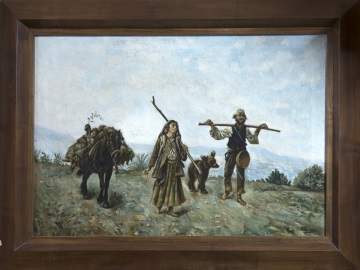
“Gypsies”. Oil on canvas. Signed “A. Briones”. 20th century. Oil on canvas showing a natural landscape in the background, barely sketched, to give prominence to the figures moving forward in the foreground. The man on the right carries a staff on his shoulders and a series of items, and is accompanied by a bear cub. In the centre, a woman walks with a stick on her shoulder, leading a mount loaded with more objects and some children by the reins. The painting shows a family of gypsies on their way to a show in which they would use the bear cub. Between the 15th and 18th centuries, the artistic image of gypsies was stereotyped and very scarce, with some engravings, tapestries and paintings such as “Landscape with Gypsies” by David Teniers III in the Prado Museum (inv. Poo1818). The 19th century was the moment of the emergence of the gypsy motif in the visual arts, due to the interest of foreign artists attracted by the “exotic” nature of these people, exhibiting what they considered to be their most folkloric features, especially highlighting works by Fortuny and Sorolla. This work aims to focus on the particularities of the Gypsy people, but without limiting itself to their stereotypes, clearly showing the harshness of their life and the loneliness that it brought with it. Technically, it can be seen its relationship with new contributions that appeared in French painting since the end of the 19th century. Thematically, it is reminiscent of works of social realism (a pictorial movement that appeared in France towards the middle of the 19th century).
· Size: 97x64 cms. 86x117 cms.
DECORATIVE ANTIQUES
PAINTINGS
Ref.: Z4081
-
Chest. Walnut wood, iron. Burgos, 17th century. Rectangular chest with a flat lid made of carved walnut wood, with corners and a latch at the front to lock it with a key, and a carved decoration on the bottom with simple geometric elements, and simple lines on the outer edge of the lid. This type of furniture was very common in Spain, frequently used to store objects of a certain value such as clothes, dishes, etc.
· Size: 169x52x73 cms.
ANTIQUES
FURNITURE
Ref.: Z4841
-
Grille with two gates. Wrought iron. Spain, 17th century. A wrought iron window grille featuring two smooth, circular cross-section rails in the center, inserted between the vertical bars. These rails are decorated with small discs and balustrade-like shapes (adding a subtle sense of movement) between the two rails, with the two pieces facing each other to create harmony. The decorative details mentioned refer to Baroque works of this material from the 17th century: compare, for example, with the balconies of the Casa de Panadería in the Plaza Mayor of Madrid, or with Spanish pieces preserved in the Victoria and Albert Museum in London, a confessional grille in the Metropolitan Museum of New York dated 1629 (inv. 57.137.51) and another in the same museum made by the master Francisco González (inv. 56-234.12Ad).
· Size: 120x38x133 cms.
ANTIQUES
MISCELLANEUS;OTHER OBJECTS
Ref.: Z5602
-
Display case. Walnut wood. 19th century. A tall display cabinet made of carved walnut wood with interior shelves and a glass door secured with a key, decorated with a series of carvings of architectural elements with a clear classical influence. These details show a certain French influence, something common in 19th-century European furniture.
· Size: 38x70x166 cms.
DECORATIVE ANTIQUES
FURNITURE
Ref.: Z5731
-
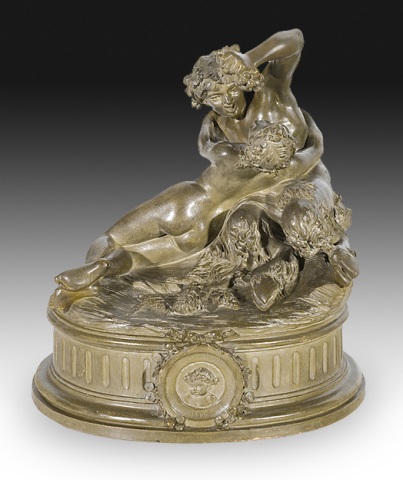
“Satyr”. Patinated terracotta. Following models by CLODION, Claude Michel (France, 1738-1814). Late 19th century-early 20th century. A patinated terracotta sculpture consisting of an oval base decorated with simple architectural elements of classical influence and a tondo with a bust enhanced by a garland and two figures. These, lying on the upper part, are a satyr (with his usual goat-like legs) raising a bunch of grapes, and a young nymph, who embraces him while trying to reach these fruits. Compare this sculpture (not so much the base) with the one entitled “Nymph and Satyr” from the Calouste Gulbenkian Museum in Lisbon (Portugal), related to the sculptor Claude Michel, highlighting the similarities and differences. Pieces similar to the present work, also known as “Satyr Feeding a Nymph Grapes”, are kept in several private collections. Claude Michel “Clodion” (1730-1814) was a French sculptor who trained with Lambert Sigisbert Adam and Jean-Baptiste Pigalle. He was recognised with numerous awards (the Prix de Rome in 1762, etc.) and had an important workshop in Paris from 1771. Although he also produced large-scale works, he is above all known for his small-format sculptural works, made in bronze (or other materials such as corrugated iron or terracotta, for example), and which had a very important influence both during the sculptor's lifetime and long after his death on a large number of works inspired by his creations.
· Size: 38x31x40 cms.
ANTIQUES
SCULPTURE
Ref.: Z5882
-
CASWELL, William Frederick (United Kingdom, act. 1870 – 1914). "Landscape". Watercolor on paper. Signed with initials in the lower right corner. . In this work, Caswell offers us an evocative landscape with romantic roots, typical of English landscape painting of the time, worked with a light and translucent chromatism that gives a special luminosity to the scene, enhancing at the same time its mysterious atmosphere. William F. Caswell, a British painter active between 1870 and 1914, worked in landscape and portraiture using oil and watercolor, and also produced series of prints such as "Le Barnabooth et autres bêtes modernes." He was a member of the Royal Birmingham Society of Artists, where he exhibited his works regularly.
· Size: 78x103 int 49x71 cms
ANTIQUES
PAINTINGS
Ref.: Z6194
-
Box in enamelled porcelain and engraved glass. 19th century. Oval box with a base made of etched glass and a hinged lid, the latter made by combining enamel and metal. The lower part presents a bucolic landscape, with a series of human figures and buildings in it, combining trees with lakes and solid ground. The scene on the upper part responds to the same typology: a couple in an idealized rural landscape.
· Size: 7,5x6x4,5 cms.
ANTIQUES
MISCELLANEUS;OTHER OBJECTS
Ref.: Z6447
-
Table. Walnut wood. 17th century. Table with a plain rectangular top and two drawers at the front, decorated with simple geometric shapes on their fronts, leaving a strip with tabs between them. The legs, joined at their lower rectangular joint by a plain stretcher, display elaborate turned disc carving, following the usual Baroque style.
· Size: 64x97x74 cms.
ANTIQUES
FURNITURE
Ref.: Z6778
-
Toiletry bag. 19th century. Tortoiseshell, metal, glass. Rectangular case with a hinged lid made of tortoiseshell decorated with fine inlaid plant and floral elements on its sides, containing a toiletry bag set composed of various feminine toiletries and personal items (a small perfume bottle, scissors, a thimble, etc.), with a space designed for each of these utensils.
· Size: 6x3x8 cms.
ANTIQUES
MISCELLANEUS;OTHER OBJECTS
Ref.: Z6854
-
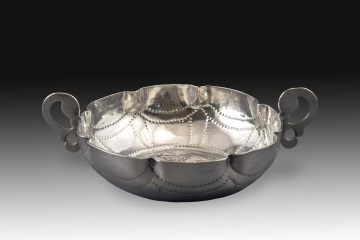
Catavinos or quaking glass. Silver. 18th century. Without contrast marks. Vessel known as catavinos or tembladera with two flat, closed “S” shaped handles and a line of “bites” (gallon-shaped shapes) highlighted by bands of dots that move to the inside of the piece. The bottom has a star shape (leaving smooth and with a shiny finish some stripes forming a Maltese Cross, and combining in the rest areas in the same finish with others in diamond-shaped lustre with dots). The bernegales and tembladeras with mortise-shaped pieces were frequent pieces in Spanish silverwork in the 17th century, usually being relegated to centres of somewhat less importance in the 18th century. Compare this with pieces such as the silver bernegal from the last third of the 17th century in the Lázaro Galdiano Museum (perhaps from the Portuguese school; inventory 3916), or the one dated between 1640 and 1665 from the same museum (inventory 3910), or the one by José Jiménez de Illescas (inventory 3915, dated 1715-1725) in the same institution. Weight: 83 gr.
· Size: 14,5x11x3 cms.
ANTIQUES
MISCELLANEUS;SILVER
Ref.: ZE192
-
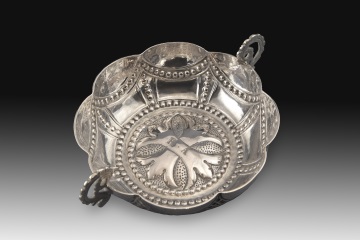
Catavinos or quaking glass. Silver. 18th century. Without hallmarks. With ownership initials. Vessel known as a catavinos or tembladera with two curved flat handles decorated with simplified plant elements, and a line of morsels (gallon-shaped shapes) on the edge enhanced by bands of sunken dots that remain in relief on the inside of the piece, where they extend and frame the decoration on the bottom. In this area there is a florentine Greek cross in a smooth shiny finish with the letters “RA” engraved (initials of the property), highlighted on a dotted background. The bernegales and tembladeras with mortise-shaped pieces were frequent pieces in Spanish silverwork in the 17th century, usually being relegated to centres of somewhat less importance in the 18th century. Compare this with pieces such as the silver bernegal from the last third of the 17th century in the Lázaro Galdiano Museum (perhaps from the Portuguese school; inventory 3916), or the one dated between 1640 and 1665 from the same museum (inventory 3910), or the one by José Jiménez de Illescas (inventory 3915, dated 1715-1725) in the same institution. Weight: 94 gr.
· Size: 13,5x10,5x4,5 cms
ANTIQUES
MISCELLANEUS;SILVER
Ref.: ZE193
-
Catavinos or quaking glass. Silver. 17th century. Without contrast marks. Vessel known as a catavinos or tembladera with two flat, closed “S”-shaped handles (with simplified plant decoration) and a line of “bites” (gallon-shaped shapes) highlighted with bands of dots. On the bottom, inside, there is an eight-petaled flower engraved with a cross inside. The bernegales and tembladeras with mortise-shaped pieces were frequent pieces in Spanish silverwork in the 17th century, usually being relegated to centres of somewhat less importance in the 18th century. Compare this with pieces such as the silver bernegal from the last third of the 17th century in the Lázaro Galdiano Museum (perhaps from the Portuguese school; inventory 3916), or the one dated between 1640 and 1665 from the same museum (inventory 3910), or the one by José Jiménez de Illescas (inventory 3915, dated 1715-1725) in the same institution. Weight: 96 gr.
· Size: 15x10,5x4,5 cms.
ANTIQUES
MISCELLANEUS;SILVER
Ref.: ZE195
-
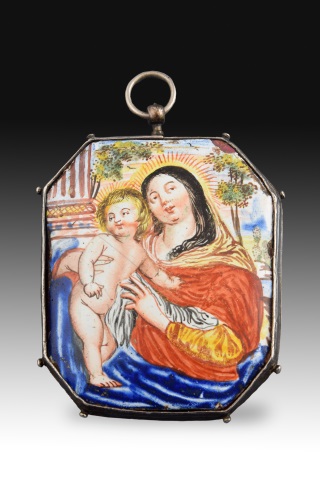
Reliquary pendant. Silver, enamel, textile. 17th century. A large polygonal pendant with a silver frame in its colour decorated with small pearls of the same material located in the corners of the edge, which has a ring at the top so that it can be hung or carried. One of its fronts has a textile background under a sheet of transparent glass, probably designed to contain relics. The other has a brightly coloured enamel showing the Virgin Mary in three-quarters, with the naked Child Jesus in her arms and both figures cut out against a landscape background with classicist architectural elements (a column with a fluted shaft on a pedestal, with mouldings) and details of a natural landscape (thus linking the moment with the Rest on the Flight into Egypt; compare, also, with works such as the Virgin and Child by Anton van Dyck from the Cerralbo Museum in Madrid or the oil painting from The Walters Art Museum, or the engraving by Paulus Pontius following Van Dyck's models - where the elements coincide in arrangement with those of the medallion -, for example). This type of jewellery has always had great value, both for the materials used and for its religious content. Despite this (or perhaps because of this same appreciation) there are not many examples of quality and in good condition, and it is possible to find them only in important private collections and in outstanding museums such as the Fundación Valencia de Don Juan in Madrid, the Museo Nacional de Artes Decorativas in the same city, etc., or old religious centres such as the Convent of the Descalzas Reales in Madrid.
· Size: 6,5x0.5x8 cms.
ANTIQUES
MISCELLANEUS;JEWELRY
Ref.: ZF0399
-
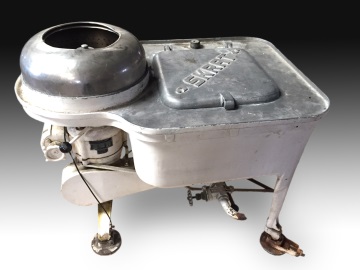
Washing machine. Metal, etc. SKRAT, model P-7, Leonard Ryznar, circa 1945. Metal washing machine with an electric motor that would drive a circular container (which moves the clothes, a “drum”), with a water inlet at the bottom to the right and with several valves and levers, as well as four circular base legs. to better support the ground and prevent, as far as possible, the machine from moving when it was in operation. Leonard Ryznar (or Rýznar) was the founder of the Skrat company, which made several models similar to the present one, very popular among those who could afford them in certain areas of Europe in the 20th century. As indicated on the aircraft itself, it is the P-7 model, produced around 1945. Towards the beginning of the 19th century, several “machines” were developed for washing clothes, consisting of a wooden box in which the clothes were placed and a manually operated system that moved them. Another variant was those that had a drum in which the clothes were pressed. clothes to wring them out. Electric washing machines were not created until the beginning of the 20th century (these appliances were already being advertised in the United States in 1904; apparently, the first one in Europe appeared somewhat later), becoming a mass appliance from the end of the 1900s onwards. from the 1940s to the early 1950s, and in Western Europe developed into an everyday appliance from about 1960.
· Size: 96x64x82 cms.
DECORATIVE ANTIQUES
MISCELLANEUS
Ref.: ZF0413
-
Low table, Dancer. Bronze, glass. 20th century. Glass defect. Low table with a transparent oval glass top, supported by a bronze female figure of a dancer in a dancing pose. The figure is inspired by 19th-century models derived from the French school, specifically works by Moreau. Weight with glass: 103 kg
· Size: 120x79x82 cms. vidrio: 82x122x1.5 cms.
DECORATIVE ANTIQUES
FURNITURE
Ref.: ZF1327
-
Pitcher with tray. Silver (915). Spain, 20th century. With contrast markings. A pitcher and tray made of silver in its natural color; the pitcher features a decoration of vines and grapes on the handle, and the tray has a rim in the style common in antique Spanish silverware. Hallmarks identify it as a 20th-century Spanish work, by Montejo silversmiths and another unidentified silversmith. Weight: 827 grams.
· Size: 26x26x29 cms.
DECORATIVE ANTIQUES
MISCELLANEUS
Ref.: ZF1490
-
Ameyaltepec, Guerrero. Tempera on paper. Venancio, Eugenio. Mexico, 20th century. Naïve rural landscape titled in the lower right and signed in the lower left, with people, buildings, animals, and plants in various poses, framed by lines and stripes of plant elements, all in flat, vivid colors. Eugenio Venancio was an artist active in the 20th century, with work held in several private collections and institutions such as the Musée International dÀrt Naïf de Magog in Canada.
· Size: 39x0,1x59,5 cms
DECORATIVE ANTIQUES
PAINTINGS
Ref.: ZF135454